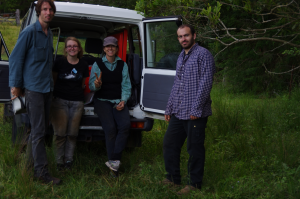 Reforestation of riparian zones is increasingly practiced in many regions to achieve multiple objectives including biodiversity conservation, bank stabilisation, and improvement in water quality. Despite this, actual benefits of reforestation for recovering underlying soil properties and function remain poorly understood. Here we compare remnant riparian rainforest, pasture and reforestation plantings aged 2-20 years in an Australian subtropical catchment on ferrosols to determine the extent to which reforestation restores these soil properties. Of the nine soil attributes measured (total nitrogen, nitrate and ammonium concentrations, net nitrification and ammonification rates, organic carbon, bulk density, fine root biomass and water infiltration rates), only infiltration rates were significantly lower in pasture than remnant riparian rainforest. Within reforestation plantings, bulk density decreased up to 1.4-fold and infiltration rates increased up to 60-fold with time post-reforestation. Our results suggest that the main outcome of belowground processes of early reforestation is the recovery of the soils’ physical structure, with potential beneficial ecosystem services to include reduced runoff, erosion and associated sediment and nutrient loads in waterways. We also demonstrate differential impacts of two commonly planted tree species on a subset of soil properties suggesting that preferential planting of select species could accelerate progress on specific restoration objectives.
Reforestation of riparian zones is increasingly practiced in many regions to achieve multiple objectives including biodiversity conservation, bank stabilisation, and improvement in water quality. Despite this, actual benefits of reforestation for recovering underlying soil properties and function remain poorly understood. Here we compare remnant riparian rainforest, pasture and reforestation plantings aged 2-20 years in an Australian subtropical catchment on ferrosols to determine the extent to which reforestation restores these soil properties. Of the nine soil attributes measured (total nitrogen, nitrate and ammonium concentrations, net nitrification and ammonification rates, organic carbon, bulk density, fine root biomass and water infiltration rates), only infiltration rates were significantly lower in pasture than remnant riparian rainforest. Within reforestation plantings, bulk density decreased up to 1.4-fold and infiltration rates increased up to 60-fold with time post-reforestation. Our results suggest that the main outcome of belowground processes of early reforestation is the recovery of the soils’ physical structure, with potential beneficial ecosystem services to include reduced runoff, erosion and associated sediment and nutrient loads in waterways. We also demonstrate differential impacts of two commonly planted tree species on a subset of soil properties suggesting that preferential planting of select species could accelerate progress on specific restoration objectives.
Click here to open the research paper manuscript
Click here to open the presentation notes

